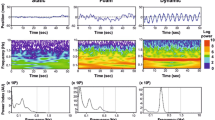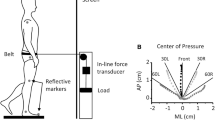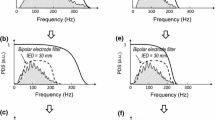Abstract
Optimal levels of noise stimulation have been shown to enhance the detection and transmission of neural signals thereby improving the performance of sensory and motor systems. The first series of experiments in the present study aimed to investigate whether subsensory electrical noise stimulation applied over the triceps surae (TS) in seated subjects decreases torque variability during a force-matching task of isometric plantar flexion and whether the same electrical noise stimulation decreases postural sway during quiet stance. Correlation tests were applied to investigate whether the noise-induced postural sway decrease is linearly predicted by the noise-induced torque variability decrease. A second series of experiments was conducted to investigate whether there are differences in torque variability between conditions in which the subsensory electrical noise is applied only to the TS, only to the tibialis anterior (TA) and to both TS and TA, during the force-matching task with seated subjects. Noise stimulation applied over the TS muscles caused a significant reduction in force variability during the maintained isometric force paradigm and also decreased postural oscillations during quiet stance. Moreover, there was a significant correlation between the reduction in force fluctuation and the decrease in postural sway with the electrical noise stimulation. This last result indicates that changes in plantar flexion force variability in response to a given subsensory random stimulation of the TS may provide an estimate of the variations in postural sway caused by the same subsensory stimulation of the TS. We suggest that the decreases in force variability and postural sway found here are due to stochastic resonance that causes an improved transmission of proprioceptive information. In the second series of experiments, the reduction in force variability found when noise was applied to the TA muscle alone did not reach statistical significance, suggesting that TS proprioception gives a better feedback to reduce force fluctuation in isometric plantar flexion conditions.





Similar content being viewed by others
Abbreviations
- ANOVA:
-
Analysis of variance
- AP:
-
Anterior–posterior
- COP:
-
Center of pressure
- COPap:
-
COP in the anterior–posterior axis
- COPml:
-
COP in the medio-lateral axis
- ML:
-
Medio-lateral
- MVC:
-
Maximal voluntary contraction
- N:
-
Newton(s)
- OS:
-
Optimal stimulation
- RMS:
-
Root-mean square
- RMSap:
-
COPap RMS
- RMSml:
-
COPml RMS
- SD:
-
Standard deviation
- ST:
-
Sensory threshold
- TA:
-
Tibialis anterior
- TS:
-
Triceps surae
- VMap:
-
COPap velocity
- VMml:
-
COPml velocity
References
Baweja HS, Patel BK, Martinkewiz JD, Vu J, Christou EA (2009) Removal of visual feedback alters muscle activity and reduces force variability during constant isometric contractions. Exp Brain Res 197:35–47
Baweja HS, Patel BK, Neto OP, Christou EA (2011) The interaction of respiration and visual feedback on the control of force and neural activation of the agonist muscle. Hum Mov Sci 30:1022–1038
Collins JJ, Imhoff TT, Grigg P (1996) Noise-enhanced tactile sensation. Nature 383:770
Collins JJ, Priplata AA, Gravelle DC, Niemi J, Harry J, Lipsitz LA (2003) Noise-enhanced human sensorimotor function. IEEE Eng Med Biol Mag 22:76–83
Di Giulio I, Maganaris CN, Baltzopoulos V, Loram ID (2009) The proprioceptive and agonist roles of gastrocnemius, soleus and tibialis anterior muscles in maintaining human upright posture. J Physiol 587:2399–2416
Dickstein R, Laufer Y, Katz M (2006) TENS to the posterior aspect of the legs decreases postural sway during stance. Neurosci Lett 393:51–55
Enoka RM, Christou EA, Hunter SK, Kornatz KW, Semmler JG, Taylor AM, Tracy BL (2003) Mechanisms that contribute to differences in motor performance between young and old adults. J Electromyogr Kinesiol 13:1–12
Faisal AA, Selen LP, Wolpert DM (2008) Noise in the nervous system. Nat Rev Neurosci 9:292–303
Fitzpatrick R, Rogers DK, McCloskey DI (1994) Stable human standing with lower-limb muscle afferents providing the only sensory input. J Physiol 480(Pt 2):395–403
Gatev P, Thomas S, Kepple T, Hallett M (1999) Feedforward ankle strategy of balance during quiet stance in adults. J Physiol 514(Pt 3):915–928
Gravelle DC, Laughton CA, Dhruv NT, Katdare KD, Niemi JB, Lipsitz LA, Collins JJ (2002) Noise-enhanced balance control in older adults. Neuroreport 13:1853–1856
Kimura T, Kouzaki M, Masani K, Moritani T (2011) Unperceivable noise to active light touch effects on fast postural sway. Neurosci Lett. doi:10.1016/j.neulet.2011.10.058
Kouzaki M, Shinohara M (2010) Steadiness in plantar flexor muscles and its relation to postural sway in young and elderly adults. Muscle Nerve 42:78–87
Lakie M, Caplan N, Loram ID (2003) Human balancing of an inverted pendulum with a compliant linkage: neural control by anticipatory intermittent bias. J Physiol 551:357–370
Loram ID, Maganaris CN, Lakie M (2004) Paradoxical muscle movement in human standing. J Physiol 556:683–689
Loram ID, Maganaris CN, Lakie M (2005a) Active, non-spring-like muscle movements in human postural sway: how might paradoxical changes in muscle length be produced? J Physiol 564:281–293
Loram ID, Maganaris CN, Lakie M (2005b) Human postural sway results from frequent, ballistic bias impulses by soleus and gastrocnemius. J Physiol 564:295–311
Loram ID, Maganaris CN, Lakie M (2007) The passive, human calf muscles in relation to standing: the short range stiffness lies in the contractile component. J Physiol 584:677–692
Loram ID, Lakie M, Di Giulio I, Maganaris CN (2009) The consequences of short-range stiffness and fluctuating muscle activity for proprioception of postural joint rotations: the relevance to human standing. J Neurophysiol 102:460–474
Magalhaes FH, Kohn AF (2011) Vibratory noise to the fingertip enhances balance improvement associated with light touch. Exp Brain Res 209:139–151
Manjarrez E, Diez-Martinez O, Mendez I, Flores A (2002) Stochastic resonance in human electroencephalographic activity elicited by mechanical tactile stimuli. Neurosci Lett 324:213–216
Manjarrez E, Rojas-Piloni G, Mendez I, Flores A (2003) Stochastic resonance within the somatosensory system: effects of noise on evoked field potentials elicited by tactile stimuli. J Neurosci 23:1997–2001
Manjarrez E, Mendez I, Martinez L, Flores A, Mirasso CR (2007) Effects of auditory noise on the psychophysical detection of visual signals: cross-modal stochastic resonance. Neurosci Lett 415:231–236
Martinez L, Perez T, Mirasso CR, Manjarrez E (2007) Stochastic resonance in the motor system: effects of noise on the monosynaptic reflex pathway of the cat spinal cord. J Neurophysiol 97:4007–4016
Masani K, Vette AH, Kawashima N, Popovic MR (2008) Neuromusculoskeletal torque-generation process has a large destabilizing effect on the control mechanism of quiet standing. J Neurophysiol 100:1465–1475
Matthews PB (1981) Evolving views on the internal operation and functional role of the muscle spindle. J Physiol 320:1–30
Matthews PB, Stein RB (1969) The sensitivity of muscle spindle afferents to small sinusoidal changes of length. J Physiol 200:723–743
McDonnell MD, Abbott D (2009) What is stochastic resonance? Definitions, misconceptions, debates, and its relevance to biology. PLoS Comput Biol 5:e1000348
McDonnell MD, Ward LM (2011) The benefits of noise in neural systems: bridging theory and experiment. Nat Rev Neurosci 12:415–426
Mello EM, Kohn AF (2009) Torque fluctuations during quite stance (in Portuguese). In: Brazilian congress of biomechanics (CD-ROM). Brazilian Society of Biomechanics, São Paulo
Mezzarane RA, Kohn AF (2009) A method to estimate EMG crosstalk between two muscles based on the silent period following an H-reflex. Med Eng Phys 31:1331–1336
Nashner LM (1976) Adapting reflexes controlling the human posture. Exp Brain Res 26:59–72
Oliveira LF, Simpson DM, Nadal J (1996) Calculation of area of stabilometric signals using principal component analysis. Physiol Meas 17:305–312
Priplata A, Niemi J, Salen M, Harry J, Lipsitz LA, Collins JJ (2002) Noise-enhanced human balance control. Phys Rev Lett 89:238101
Priplata AA, Niemi JB, Harry JD, Lipsitz LA, Collins JJ (2003) Vibrating insoles and balance control in elderly people. Lancet 362:1123–1124
Priplata AA, Patritti BL, Niemi JB, Hughes R, Gravelle DC, Lipsitz LA, Veves A, Stein J, Bonato P, Collins JJ (2006) Noise-enhanced balance control in patients with diabetes and patients with stroke. Ann Neurol 59:4–12
Proske U (2006) Kinesthesia: the role of muscle receptors. Muscle Nerve 34:545–558
Ross SE (2007) Noise-enhanced postural stability in subjects with functional ankle instability. Br J Sports Med 41:656–659 discussion 659
Rothwell JC (1994) Control of human voluntary movement. Chapman & Hall, London
Stubbs PW, Nielsen JF, Sinkjaer T, Mrachacz-Kersting N (2011) Phase modulation of the short-latency crossed spinal response in the human soleus muscle. J Neurophysiol 105:503–511
Tabachnick BG, Fidell LS (2007) Using multivariate statistics. Pearson Education, Boston
Zhou S (2000) Chronic neural adaptations to unilateral exercise: mechanisms of cross education. Exerc Sport Sci Rev 28:177–184
Acknowledgments
This research was funded by CNPq. The first author is a recipient of a fellowship from FAPESP, grant #2011/13222-6. We are grateful to Sandro A. Miqueleti for his invaluable technical support, and we thank Dr. Rinaldo A. Mezzarane for his useful comments.
Author information
Authors and Affiliations
Corresponding author
Rights and permissions
About this article
Cite this article
Magalhães, F.H., Kohn, A.F. Imperceptible electrical noise attenuates isometric plantar flexion force fluctuations with correlated reductions in postural sway. Exp Brain Res 217, 175–186 (2012). https://doi.org/10.1007/s00221-011-2983-6
Received:
Accepted:
Published:
Issue Date:
DOI: https://doi.org/10.1007/s00221-011-2983-6




